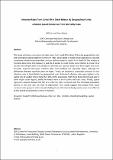Files in this item
Infection rates from Covid-19 in Great Britain by geographical units : a model-based estimation from mortality data
Item metadata
| dc.contributor.author | Kulu, Hill | |
| dc.contributor.author | Dorey, Peter | |
| dc.date.accessioned | 2020-07-31T09:30:11Z | |
| dc.date.available | 2020-07-31T09:30:11Z | |
| dc.date.issued | 2020-05-24 | |
| dc.identifier | 269404048 | |
| dc.identifier | 7fb18216-b6db-469b-b5d5-e0b1ea681b17 | |
| dc.identifier.citation | Kulu , H & Dorey , P 2020 , ' Infection rates from Covid-19 in Great Britain by geographical units : a model-based estimation from mortality data ' , SocArXiv . https://doi.org/10.31235/osf.io/84f3e | en |
| dc.identifier.other | ORCID: /0000-0001-8808-0719/work/78205079 | |
| dc.identifier.other | ORCID: /0000-0002-5213-644X/work/78205142 | |
| dc.identifier.uri | https://hdl.handle.net/10023/20383 | |
| dc.description.abstract | This study estimates cumulative infection rates from Covid-19 in Great Britain by geographical units and investigates spatial patterns in infection rates. We propose a model-based approach to calculate cumulative infection rates from data on observed and expected deaths from Covid-19. Our analysis of mortality data shows that between 5 and 6% of people in Great Britain were infected by Covid-19 by the last third of April 2020. It is unlikely that the infection rate was lower than 3% or higher than 12%. Secondly, England had higher infection rates than Scotland and Wales, although the differences between countries were not large. Thirdly, we observed a substantial variation in virus infection rates in Great Britain by geographical units. Estimated infection rates were highest in the capital city of London where more than 10% of the population might have been infected and also in other major urban regions, while the lowest were in small towns and rural areas. Finally, spatial regression analysis showed that the virus infection rates increased with the increasing population density of the area and the level of deprivation. The results suggest that people from lower socioeconomic groups in urban areas (including those with minority backgrounds) were most affected by the spread of coronavirus in March and April. | |
| dc.format.extent | 19 | |
| dc.format.extent | 771428 | |
| dc.language.iso | eng | |
| dc.relation.ispartof | SocArXiv | en |
| dc.subject | Covid-19 | en |
| dc.subject | Infectious diseases | en |
| dc.subject | Infection rates | en |
| dc.subject | Mortality | en |
| dc.subject | Statistical modelling | en |
| dc.subject | Spatial analysis | en |
| dc.subject | RA0421 Public health. Hygiene. Preventive Medicine | en |
| dc.subject | HA Statistics | en |
| dc.subject | G Geography (General) | en |
| dc.subject | 3rd-DAS | en |
| dc.subject | SDG 3 - Good Health and Well-being | en |
| dc.subject.lcc | RA0421 | en |
| dc.subject.lcc | HA | en |
| dc.subject.lcc | G1 | en |
| dc.title | Infection rates from Covid-19 in Great Britain by geographical units : a model-based estimation from mortality data | en |
| dc.type | Journal article | en |
| dc.contributor.institution | University of St Andrews. Population and Health Research | en |
| dc.contributor.institution | University of St Andrews. Sir James Mackenzie Institute for Early Diagnosis | en |
| dc.contributor.institution | University of St Andrews. School of Geography & Sustainable Development | en |
| dc.identifier.doi | https://doi.org/10.31235/osf.io/84f3e | |
| dc.description.status | Non peer reviewed | en |
This item appears in the following Collection(s)
Items in the St Andrews Research Repository are protected by copyright, with all rights reserved, unless otherwise indicated.

